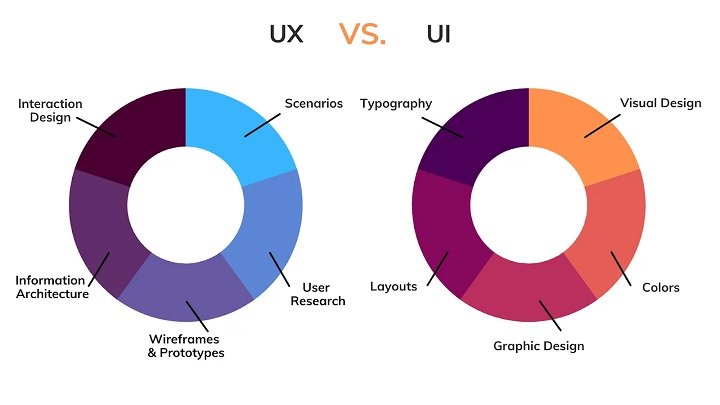Ideally, an objective third party should run your UX audit. This could be an outside consultant or a company specializing in UX evaluations.
If you don’t have the budget for an outside firm, you can still do an audit internally. Just make sure to choose someone familiar with UX best practices and who has the time to devote to a thorough evaluation.
As for when: it’s generally a good idea to do a UX audit whenever you make major changes to your website or app. This could be before a redesign, after you add a new feature, or any time you want to take a closer look at your user experience.
But what exactly does a UX audit involve? Let’s take a look.
The Core of UX: What Is UX Design?
UX design—or user experience design—is the process of building products that are not only functional but also delightful and intuitive for users. It spans everything from the layout of a screen to how smoothly a user can navigate through a task. UX designers often act as a bridge between business goals and user needs, ensuring that products feel easy, natural, and effective to use.
At its heart, UX design is problem-solving. It’s about understanding what users are trying to achieve and designing experiences that help them get there with minimal friction. That includes wireframing, prototyping, usability testing, and collaborating with UI designers and developers. A good UX designer is always advocating for the user while balancing the practicalities of business and tech.
The Role of User Research in UX
Now, where does user research come in? Simply put, user research is the foundation upon which effective UX design is built. It involves collecting insights about users—their goals, motivations, behaviors, pain points, and expectations. This can be done through interviews, surveys, usability testing, analytics, and observation.
User research helps prevent guesswork in design. It ensures that decisions are grounded in real data, not assumptions. Without user research, a product might look good and even function well—but miss the mark completely in terms of actual user needs. That’s why it’s often said that user research answers the “why” behind the “what” of UX.
While user research and UX design are different in function, they are closely intertwined. In fact, many UX designers conduct research themselves, especially in smaller teams. However, in more mature organizations, there may be dedicated user researchers who work alongside designers to ensure the experience is informed by real human behavior.
Key Differences in Focus
One of the clearest distinctions between UX design and user research is in their focus. UX design focuses on solutions—how to design the product, what features to prioritize, and how users will interact with them. It’s hands-on, creative, and iterative.
User research, on the other hand, is all about discovery. It’s about asking the right questions, finding patterns, and uncovering insights that drive the design process. Rather than making decisions, user research informs decisions.
If you think of the product development journey as a map, user research draws the path, while UX design builds the road. You can’t get to the destination without both.
Working Together: A Collaborative Process
In an ideal workflow, user research comes early and continues throughout the design and development lifecycle. Research identifies the user needs. Then the UX designer steps in to craft solutions based on those findings. Once a prototype is ready, research continues—testing, validating, and refining until the design truly resonates with users.
This cycle of research and design is what keeps great products evolving. For example, when working with a UX designer in Doha, companies often expect both elements to be present—strong user insights and thoughtful design execution that aligns with those insights. That collaboration is what leads to measurable results like higher engagement, better retention, and more conversions.
Do You Need Both?
Absolutely. Skipping user research means designing in the dark. Skipping UX design means having insights with no practical application. Together, they ensure your product is not only usable but also meaningful and enjoyable.
If you’re trying to build a product that resonates with real users, you’ll want both skill sets on your team. Whether they’re housed in one person or split across a team, the important thing is that research informs design—and that design listens to research.
Common Overlaps and Misconceptions
One common misconception is that UX design automatically includes research. While many UX designers are trained in research methods, it’s not always part of the job in every organization. Similarly, not all user researchers are involved in design decisions—they may simply provide insights and leave the implementation to designers and developers.
That’s why it’s important to clearly define roles within a team. When everyone knows who’s gathering data, who’s interpreting it, and who’s turning it into a product experience, collaboration becomes much smoother.
Also, while UX design is more visual and interactive, user research can be more abstract—filled with notes, recordings, and data points that may take time to translate into design direction. But both are equally essential for creating something users will love.
Final Thoughts
UX design and user research might operate on different levels, but they share a common mission: improving how users interact with digital products. They each bring something unique to the table—one is strategic and investigative, the other creative and practical.
The more closely they work together, the better the result. So whether you’re building a new app from scratch or optimizing an existing website, don’t think of UX and user research as separate lanes. They’re part of the same journey—and when done right, they lead to experiences that truly connect with people.
In the end, successful digital products aren’t just well-designed—they’re well understood. And that understanding begins with research, then takes shape through design.



